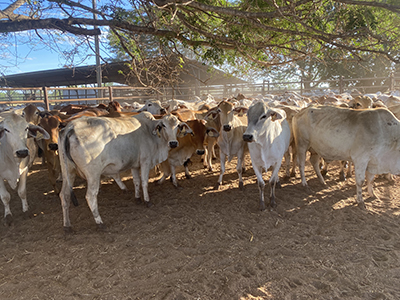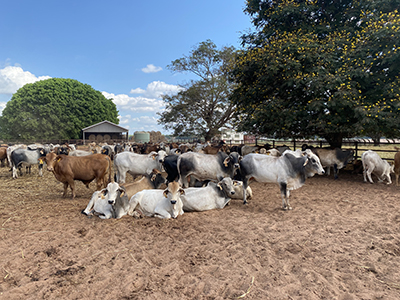Selected Brahman and composite weaning and 600 day data collection
It is widely recognised that the fertility of Brahman and Brahman cross cattle in northern Australia is lower than that of Bos taurus cattle in southern Australia. Department of Industry, Tourism and Trade (DITT) researchers have been working to improve the fertility of cattle through selection for many years and now cattle from the department’s Selected Brahman and Tropical Composite herds are involved in the Repronomics 2 project. This a collaborative project with the Animal Genetics and Breeding Unit (AGBU) at the University of New England and Queensland DAF that aims to use genomic evaluation to increase the rate of improvement of fertility through selection by increasing the accuracy of fertility EBVs (estimated breeding values) and developing across breed EBVs.
DITT Livestock Research Officer, Gretel Bailey-Preston, has completed another busy year of musters and data collection of the Selected Brahman and Tropical Composite herds. The first round musters took place across 3 of the DITT research stations - Douglas Daly Research Farm (DDRF), Victoria River Research Station (VRRS) and Beatrice Hill Research Farm (BHRF). At all 3 properties, the 2022 calves have been weaned and relocated to DDRF where the females will remain for the next 3 years and the males for 1 year as part of the Repronomics 2 project. The cows were pregnancy tested and only kept in the breeder herd if they were pregnant within the calving window from October to December, and were lactating, indicating they had raised a calf to weaning.
Early June is the time for the 600 day data collection which is sent to Breedplan to be analysed for estimated breeding value (EBV) information. The 18-month-old male Selected Brahmans and Tropical Composites had their weight, hip height and scrotal circumference recorded, as well as a semen sample collected which is analysed (crush side for motility) before being sent away for morphology. The results from this testing are used to select the bulls for the department’s breeding program and for the following year’s annual sale. The 18-month-old females are pregnancy tested following their yearling mating, and their weight and hip height is recorded.




